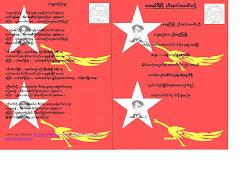Relief agencies now acknowledge that many of the fears of wide spread death from disease did not happen because the Burmese found a way to take care of themselves.
AP
Wednesday, Jun. 25, 2008 By AP/GRANT PECK
(BANGKOK, Thailand) — Dire warnings that cyclone survivors in Burma might fall prey to disease and starvation failed to take into account the survival instincts of those affected, aid agencies and disaster experts say.ဆက္ဖတ္ရန္ အၿပည္႔အစံု ကို Click ႏွိပ္ပါ။
The resilience of the people — along with the skills of Burma citizens working for local and international humanitarian agencies — proved to be the most critical survival weapons and helped mitigate the limited access allowed to foreign disaster experts, they said.
U.N. agencies and private humanitarian groups agree a feared second wave of post-cyclone casualties did not take place. And barriers the junta put in the way of foreign aid appears not to have caused a measurable increase in deaths from illness and lack of food. "These parts of Burma are visited by cyclones almost every year, although not of the same scale," said Ramesh Shrestha, the UNICEF representative in Burma. "Hence people were quite able to adapt to this sudden impact."
Burma's government said this week that a survey undertaken jointly with the U.N. and the regional Association of Southeast Asia Nations found no post-cyclone deaths related to lack of assistance, though the findings are preliminary.
No one is saying Cyclone Nargis was not a tragedy of epic proportions or that Burma's military government was justified in turning aside offers of outside aid.
The images of swollen bodies lying unattended weeks after the May 2-3 storm and lines of desperate refugees camped along roadsides waiting for food handouts testify to the failures of the initial relief effort.
The government's official death toll now stands at 84,537 dead, with 53,836 missing. But almost all the casualties appear to have been caused directly by the cyclone — surprising in view of warnings circulated immediately after the storm, when most foreign assistance and foreign aid workers were kept out of the disaster zone.b"The stories that were coming out after the disaster were very focused on what wasn't getting in," said Melanie Brooks, a spokeswoman in Bangkok for the humanitarian agency CARE.
Journalists could not get permission to enter the country, and those who sneaked in faced tight restrictions in reporting. Consequently, much of the news came from Thailand, where the main story was how the junta was rejecting outside aid.
Rest of your post
AP
Wednesday, Jun. 25, 2008 By AP/GRANT PECK
(BANGKOK, Thailand) — Dire warnings that cyclone survivors in Burma might fall prey to disease and starvation failed to take into account the survival instincts of those affected, aid agencies and disaster experts say.ဆက္ဖတ္ရန္ အၿပည္႔အစံု ကို Click ႏွိပ္ပါ။
The resilience of the people — along with the skills of Burma citizens working for local and international humanitarian agencies — proved to be the most critical survival weapons and helped mitigate the limited access allowed to foreign disaster experts, they said.
U.N. agencies and private humanitarian groups agree a feared second wave of post-cyclone casualties did not take place. And barriers the junta put in the way of foreign aid appears not to have caused a measurable increase in deaths from illness and lack of food. "These parts of Burma are visited by cyclones almost every year, although not of the same scale," said Ramesh Shrestha, the UNICEF representative in Burma. "Hence people were quite able to adapt to this sudden impact."
Burma's government said this week that a survey undertaken jointly with the U.N. and the regional Association of Southeast Asia Nations found no post-cyclone deaths related to lack of assistance, though the findings are preliminary.
No one is saying Cyclone Nargis was not a tragedy of epic proportions or that Burma's military government was justified in turning aside offers of outside aid.
The images of swollen bodies lying unattended weeks after the May 2-3 storm and lines of desperate refugees camped along roadsides waiting for food handouts testify to the failures of the initial relief effort.
The government's official death toll now stands at 84,537 dead, with 53,836 missing. But almost all the casualties appear to have been caused directly by the cyclone — surprising in view of warnings circulated immediately after the storm, when most foreign assistance and foreign aid workers were kept out of the disaster zone.b"The stories that were coming out after the disaster were very focused on what wasn't getting in," said Melanie Brooks, a spokeswoman in Bangkok for the humanitarian agency CARE.
Journalists could not get permission to enter the country, and those who sneaked in faced tight restrictions in reporting. Consequently, much of the news came from Thailand, where the main story was how the junta was rejecting outside aid.
Rest of your post














No comments:
Post a Comment